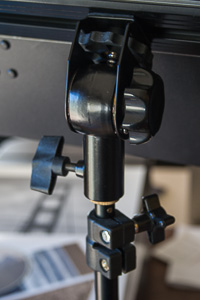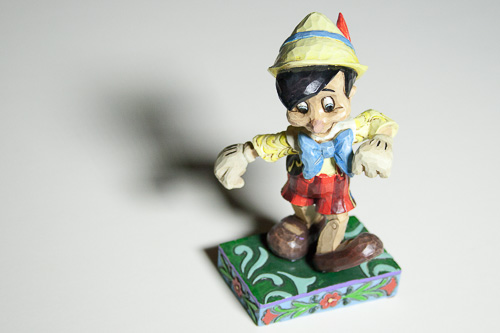Photo Corners headlinesarchivemikepasini.com
![]()
A S C R A P B O O K O F S O L U T I O N S F O R T H E P H O T O G R A P H E R
![]()
Reviews of photography products that enhance the enjoyment of taking pictures. Published frequently but irregularly.
Flashpoint 500 LED Light


12 December 2012
You know they're coming because you've seen them on the street. As red, yellow and green LED traffic lights, that is. But recently LED lighting has been showing up as lighting equipment.
There are a couple of obvious benefits.
First, they're hot lights not strobes. So after you set them up, you can actually see what shadows the light casts and change the quality of the light.
Second, they aren't really hot at all. They remain cool to the touch. So your model doesn't start to sweat or melt under a bank of them.
And they do come in banks.
Photographer Kirk Tuck has authored LED Lighting: Professional Techniques for Digital Photographers
, the standard text on the subject, if you'd like to learn more.
FEATURES
Adorama sells the $199.95 Flashpoint 500 as a kit that includes the light itself, power cords with brick, a spare fuse and a stand mounting adapter. Flashpoint is Adorama's house brand.
Let's take a look at the features:
- Color temperature is adjustable from 3200 to 5800 Kelvin
- Independent dimmers for 250 warm bulbs and 250 cool bulbs
- CRI is 79 (see below)
- AC power from the wall or optional battery pack
- 500 "ultra bright" 5mm LED bulbs generating 42 watts
- Four barndoors for directional lighting
- Compact at 14 x 7.5 x 2.75 inches
The optional battery pack is a $199.99 V Lock mount lithium-ion with 162.8 watts, 14.8 volts and 2 amps. It just snaps into the back of the housing.
INSTALLATION
There's no manual included with the light but it isn't hard to figure out.

Adapter. Mounted on a Photoflex light stand.
The first decision we had to make was whether to mount the light horizonatally or vertically. You can slide the stand adapter into any corner and slip it into rails that run along any side. Very convenient and pretty quick, too, if you want to change the setup on the fly.
We opted to position the handle on the top of the unit to make it easy to swing around and carry from one spot to another in the bunker.
We opened the locking nut all the way to slip the adapter onto the top of standard Photoflex light stand.
The barn doors have an acqua reflector on the inside and open stiffly to hold position. With a couple of clothespins, they can also hold various diffusers.
The power connector has a latch that locks the connector into the back of the unit. Not a bad idea on a busy set. The brick sat on the floor and a power cable stretched about 13 feet to an outlet. Plenty of room right out of the box.
LET THERE BE LIGHT
To turn on the bulbs, you dial up one or both dimmers on the back of the unit. We experienced a little flicker at the lowest illuminations as we dialed the dimmer but the light was constant when we set it.
The LED is arranged in two banks of 250 bulbs. But the banks run in alternate columns, so the light mixes evenly. And mix you can. Completely cool. Completely warm. Anything in between.

Two Banks. Columns alternate between cool and warm bulbs.
Once we had the bulbs on, we wondered just how bright they are. We can easily flood the studio with light using one of the monoblocs. And even a small strobe packs quite a punch.
But hot lights tend to be a lot less bright. We have 60 watt bulbs on two reflectors, for example, that really don't excite us.
We examined output two ways.
First, we invited Holzmueller Productions associate Joseph Amic-Angelo to examine the unit. Holzmueller rents lighting equipment in San Francisco for all the big productions (Been to Moscone? You've been lit up by Holzemueller). Amic-Angelo, a lighting designer by trade, configures lighting setups for clients there. And he rents out LEDs, primarily for video, he told us.

Rear View. Note the battery pack connection (top right), the power connection (bottom left) and the two dimmer switches.
His reaction to the output? "Pretty bright," he nodded.
The other approach we used was to dig out the old Gossen Luna Pro and just measure the output. Yep, still works (with a battery adapter).
An incident light meter reading at two feet came up at 13 on the scale for either the cool or warm bank at full force. Both on all the way, yielded 14. That's 65 foot candles and 130 foot candles, respectively.
Compare that to the Photoflex FirstStudio FirstStar lamps, which are 250 watts. At two feet, the incident light reading is 15.5 or 380 foot candles. A lot hotter, too.
So we think Amic-Angelo meant pretty bright for LEDs.
Our test shots prove that point. We aimed the light down onto our subject from about two feet away. At ISO 400 with an aperture setting of f5.6 and 1/320 second shutter speed, we were slightly underexposed given the high-key nature of the shot. We opened the Raw images in Photoshop CS6, using the Auto correction for exposure but that was about it.

The example above is nearly monochrome, so it doesn't address the other LED question. What's the color rendering index?
CRI is a reference to the ability of the lamp to replicate the sun. It's expressed as a number between 0 to 100, in which 75 would mean 75 percent of the visible color spectrum the sun would produce. The CRI of sunlight, by definition, is 100. A 6400 Kelvin daylight bulb is 80 CRI.
Adorama told us the CRI for this lamp is 79, but we did our own test to see just what that means. We shot the same colorful model just before noon on a sunny December day outside and later that night shot him again with the Flashpoint. We used the same three settings as above.

Sunlight. In December at noon.

Exposure was quite a bit different, of course, but the Cool light matched sunlight pretty well.
MODIFYING THE LIGHT
One of the joys of artificial light is modifying it. An LED fixture presents an interesting problem.
For one thing, it's a multi-point light source. And a multi-point light source can throw a multi-shadow. The workaround is to diffuse the light by mounting a diffusion gel to the fixture, clamping it to the barn doors.
Or you can go with it using a honeycomb grid to avoid spill light and focus the output.
We used homebrew solutions to try those options. Adorama doesn't list any accessories other than the battery for the Flashpoint 500.
CONCLUSION
We aren't proud when it comes to light sources. We'll use anything. Somehow, we'll find a way to make it work. So anything that can step in for the sun in any measure gets at least one photo corner from us.
When we read the customer reviews on the Adorama site, we were more than a little concerned that one corner would be it for the Flashpoint. But the unit we reviewed seemed to be a different kit all together. For one thing, it was the kit not just the lamp itself.
We had no trouble at all with the controls or construction. In fact, we found it solidly built and yet light enough to move around easily. Two corners.
The warm bank is really warm but the cool bank is not arctic. Around here, we'd probably always shoot with the cool bank up and the warm bank no more than half up. But it's a real treat to have a dial-in white balance. Three corners.
So is it bright enough? Our exposures at ISO 400 ran from 1/80 to 1/125 second and f6.3 to f8, depending on the color balance. That's a workable range. And considering you get that light without raising the temperature in the room, it's even comfortable.
Which makes it four corners in our book.
Comments
Here's a note out of my upcoming D800 eBook/iBook:
And another:Today you can acquire a decent on-camera, hot shoe-mounted light with a hundred or more LEDs to serve as a paparazzi-like camera light in dim surroundings, or, better yet, as a fill light for back-lit outdoor scenes.
One unit in our experience is the amazingly cheap (under $30), 160-LED video light from Chromo, Inc. It takes Sony L and Panasonic CGR camcorder batteries, or six AA cells, has an on-board dimmer with a 10-stop range, battery tester, tripod socket and hot shoe adapter.
The rectangular array (16 x 10) of LEDs put out a strong amount of light from a generous 105 x 80 mm rectangle (3 x 4 ish inches), and slide in filters are included to warm the natively daylight-balanced LEDs to roughly incandescent color temperature, diffuse the output for better wide-angle coverage and a filter of the pinkish-magenta persuasion similar to a Roscolux #34 flesh-pink.
The story here is not really this unit, but what it represents and foretells about the lighting revolution. More professionally produced units with similar output can cost up to ten times as much.
The days of the giant 5K photon and heat machines is numbered. LED lighting is almost all organized as a glowing surface area, not a lens-projected circular beam-even the big LED fixtures used increasingly in motion picture sound stages. In the short term, a leading LED lighting technology for movie work carries the buzzword CREE LEDs, named after the company that invented them. Each CREE unit puts out much more light than standard LEDs. Many manufacturers have licensed manufacturing rights from Cree, Inc.
-- Peter iNova
Yeah, wish we had more on the role LEDs are playing in video, but it's out of our scope. We keep playing with the thing. Nice fill for sunlit stuff here. -- Mike